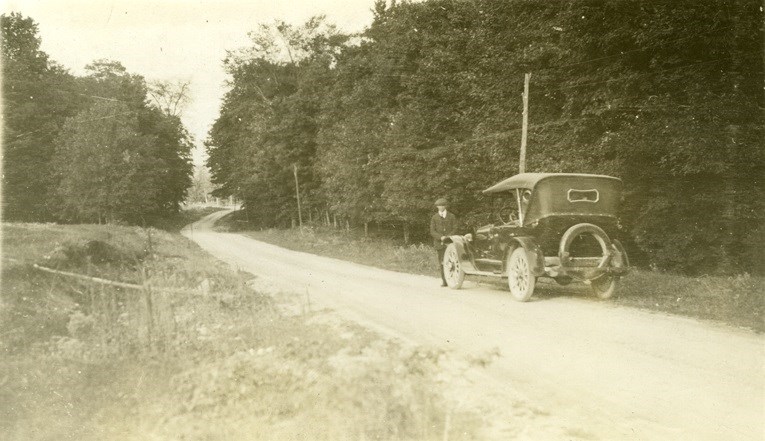From the archives of the Sault Ste. Marie Public Library:
When the snow finally leaves each year, we all participate in the springtime sport of The Great Pothole Dodge, and our forefathers also faced some harrowing trips along the roads back in their day too.
In the early 1900s the roads had been designed for horses and wagons or sleighs. The roads were simply land that had been cleared but were not necessarily level. When it rained, deep ruts would form and the result was a very rough ride for anyone trying to navigate these streets.
Some improvements to the streets occurred when street car tracks were laid along Queen Street in 1902 which remained as a part of the street surface until 1941.
With the arrival of the “horseless carriage” new problems emerged. Not only were these vehicles prone to frequent tire punctures and engine breakdowns, they also had difficulty travelling on the poor roads. It is recounted that one of the first gasoline propelled buggies in the Sault belonged to Francis H. Clergue. Unfortunately he had so much difficulty driving the “car” through the muddy streets that the vehicle had to be put into storage.
City officials realized their first step was to improve the road surfaces. Early records show that Wellington Street West (going through Steelton) was paved with blacktop in 1911. Queen Street East appears to have been paved around the same time, prior to 1912 when Sault Ste. Marie officially became a city. Of course, just like nowadays, repairs often required the road to be dug up during the spring and summer months. In 1909, Queen Street was dug up to allow for the laying of telephone lines and then once again in 1912, the street was dug up to install storm sewers!
Winter driving was a challenge in the early days as well. City Hall did not develop a policy regarding clearing snow from city streets until 1921. Even with this policy the only streets that were cleared were in the downtown. After any significant snowfall, it would take about 4 to 5 days to clear Queen Street from Pim Street to Gore Street! They would use four teams of horses and a wooden snowplow to get the job done.
Not all of the roads could be paved, so other materials were used as well. Several streets were laid with bricks instead of pavement. Between 1912 and 1914, several downtown streets including Bruce, Spring, Pim and Brock Streets were covered with bricks. The lower end of Bruce Street retained its brick surface until very recently when it was resurfaced with asphalt pavement. During this recent construction project, the bricks that could be rescued were moved to the adjacent sidewalk boulevard to preserve this last piece of road history.
Over the years, the city continued to pave streets but it was an expensive process. In 1912, it cost about $7,000 to pave one mile of road. By the early 1970s, this cost had increased to about $250,000 per mile for Class A pavement. A Class B pavement was used in some of the rural areas at a cost of $25,000 per mile.
In 1965, when Korah and Tarentorus Townships amalgamated with Sault Ste. Marie, the city inherited 159 miles of roads. Only 23 miles of these roads were paved. This would have been a daunting task for the city and taxpayers to face but over the years, these roads were gradually paved so that nowadays there are only a few roads within the city that remain unpaved.
With the arrival of spring and summer comes construction season and just like our forefathers did, we look forward to seeing those potholes filled instead of playing “dodge the pothole”!
Each week, the Sault Ste. Marie Public Library and its Archives provides SooToday readers with a glimpse of the city’s past.
Find out more of what the Public Library has to offer at www.ssmpl.ca and look for more Remember This? columns here
